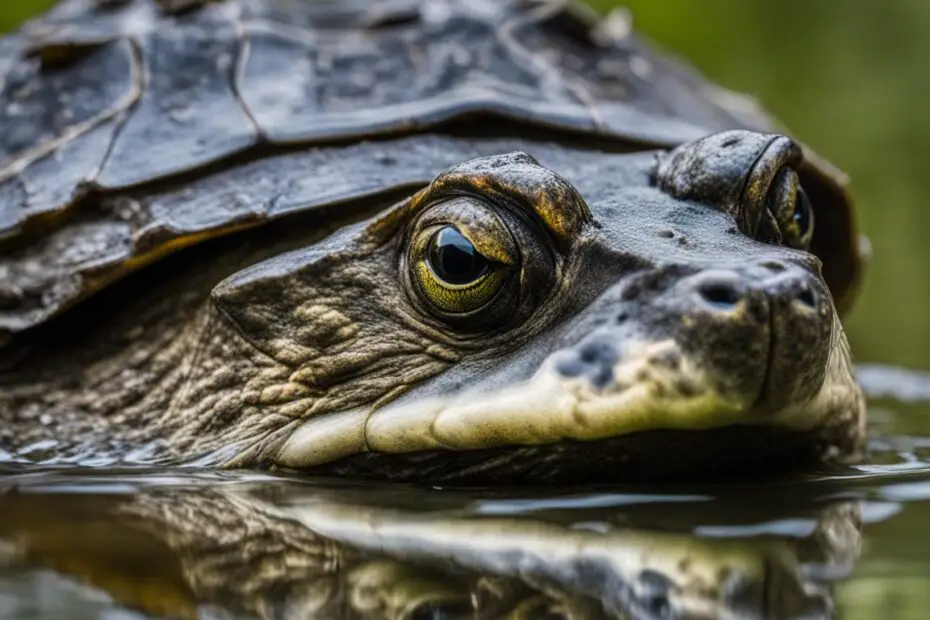The soft shell snapping turtle is a fascinating species of reptile that can be found in various habitats across North America. With its unique appearance and captivating behaviors, it has become a subject of interest for turtle enthusiasts. In this article, we will explore the physical characteristics, preferred habitats, aggressive behavior, unique adaptations, and other intriguing aspects of the soft shell snapping turtle, providing a comprehensive overview of this captivating species.
Key Takeaways:
- The soft shell snapping turtle is a captivating and formidable reptile.
- It can be found in various habitats across North America.
- This species has unique physical characteristics and fascinating behaviors.
- Soft shell snapping turtles are known for their aggressive nature.
- They possess unique adaptations that allow them to thrive in different environments.
Origin and Habitat of Soft Shell Snapping Turtles
Soft shell snapping turtles are fascinating creatures that can be found in various habitats, including freshwater lakes, rivers, swamps, marshes, and even urban areas. These adaptable turtles have the remarkable ability to thrive in different environments across North America, from Canada to the southern United States.
Soft shell snapping turtles are commonly classified as freshwater turtles due to their preference for habitats with still or slow-moving water. They are often found in bodies of water with abundant vegetation and ample food sources, such as fish, amphibians, crustaceans, and small mammals.

One of the unique characteristics of soft shell snapping turtles is their ability to make themselves at home in various habitats. This adaptability allows them to survive in both natural and man-made aquatic environments, including ponds, swamps, and even sewage treatment plants. They are known to have a broad geographic range and can be found in different regions across North America.
Soft shell snapping turtles play an important role in maintaining the ecological balance of their habitats. As carnivorous predators, they help control the population of smaller aquatic species, contributing to the overall health and diversity of the ecosystem.
Natural Habitats of Soft Shell Snapping Turtles
| Habitat Types | Features |
|---|---|
| Lakes | Large freshwater bodies with calm or slow-moving water. |
| Rivers | Waterways with varying depths and currents, providing ample hunting opportunities. |
| Swamps | Wetland areas characterized by standing water and abundant vegetation. |
| Marshes | Shallow-water habitats dominated by grasses and reeds. |
| Urban areas | Man-made habitats, such as ponds and reservoirs, found in cities and suburban areas. |
Soft shell snapping turtles have remarkable adaptability to different habitats, allowing them to inhabit both natural and urban environments. This versatility makes them intriguing creatures to observe and study in the wild.
Choosing and Buying a Soft Shell Snapping Turtle
Before bringing a soft shell snapping turtle into your home as a pet, there are several important factors to consider. These fascinating creatures require specific care and a suitable environment to thrive.
Turtle Tank Size
Soft shell snapping turtles can grow quite large, with shell lengths reaching up to 18 inches. Therefore, it is crucial to provide them with an adequately sized tank to accommodate their growth and allow for comfortable movement.
A tank of at least 75 gallons is recommended to provide enough space for the turtle. This ensures they have enough room to swim and explore their surroundings. Additionally, soft shell snapping turtles are primarily aquatic, so a larger tank mimics their natural habitat and provides a more enriching environment.
Creating the Ideal Turtle Tank
In addition to the tank size, consider incorporating the following elements into your turtle tank:
- Basking Area: Soft shell snapping turtles need a dry area to bask and regulate their body temperature. This can be achieved with a platform or a floating dock.
- Heating and Lighting: Ensure your turtle’s tank maintains a proper temperature range. A basking lamp and a UVB light are essential for their health and well-being.
- Water Quality: Regularly clean and filter the water in the tank to maintain good water quality. Use a water conditioner to remove chlorine or any harmful chemicals.
Diet and Nutrition
A well-balanced diet is crucial for the health and longevity of your pet turtle. Soft shell snapping turtles are carnivorous and require a varied diet that includes:
- Fish: Offer small fish, such as minnows or feeder fish, as a primary source of protein.
- Insects: Supplement the diet with insects like crickets, earthworms, or mealworms.
- Plants and Small Mammals: Occasionally, you can provide plant matter and small mammals as treats or to satisfy their natural feeding behavior.
Always ensure the food is appropriately sized for your turtle to prevent choking or digestive issues. A varied diet reflects their natural feeding habits and promotes optimal health.

Creating a Basking Area
Soft shell snapping turtles require a basking area where they can rest and receive UVB light. Place a sturdy platform or rock in the tank to provide a dry spot for them to climb onto. Install a heat lamp and UVB light above the basking area to provide warmth and the necessary UV radiation for their overall health.
Feeding and Hydration
Soft shell snapping turtles are carnivorous and require a varied diet to meet their nutritional needs. Offer a combination of fish, insects, plants, and small mammals to ensure a balanced diet. It’s important to provide both live and commercially prepared food options to keep their diet diverse.
Make sure to clean the tank regularly to maintain good water quality and prevent the buildup of harmful bacteria. Provide fresh, dechlorinated water for swimming and hydration at all times.
Regular Vet Check-ups
Just like any other pet, soft shell snapping turtles should receive regular check-ups from a reptile veterinarian. These professionals can provide guidance on diet, tank setup, and overall health monitoring. Regular check-ups help detect any potential issues early on, ensuring prompt treatment and a healthy pet.
“Proper care is essential for the well-being of soft shell snapping turtles. By creating a suitable habitat, providing a balanced diet, and seeking regular veterinary care, you can ensure a thriving and happy pet for years to come.” – Dr. Samantha Reynolds, Reptile Veterinarian
Handling Soft Shell Snapping Turtles
When it comes to handling soft shell snapping turtles, caution and respect for their instincts are key. These turtles can easily become stressed or agitated, so it’s important to follow proper procedures to ensure the safety of both you and the turtle. Here are some guidelines to keep in mind:
- Approach from behind: To minimize the risk of startling the turtle, always approach from behind. This way, the turtle is less likely to feel threatened and exhibit defensive behaviors.
- Support the shell: When picking up a soft shell snapping turtle, it’s crucial to support its shell properly. Gently cradle the turtle’s body and avoid grabbing its tail or limbs. This helps prevent injury to the turtle and promotes a more comfortable handling experience.
- Wash hands thoroughly: After handling a soft shell snapping turtle, make sure to wash your hands thoroughly. This simple step helps prevent the transmission of any bacteria or germs.
“Soft shell snapping turtles are fascinating creatures that require careful handling. By approaching them from behind, supporting their shell, and practicing good hygiene, you can ensure a safe and positive interaction.”
It’s important to note that soft shell snapping turtles have their own unique behavior and defensive instincts. If you’re bitten by a snapping turtle, don’t take it personally. Remember, it’s just their way of protecting themselves. Now that you’re equipped with the knowledge of proper handling techniques, you can confidently engage with these remarkable reptiles.

Soft Shell Snapping Turtle Handling Precautions
| Do’s | Don’ts |
|---|---|
| Approach from behind | Grab the turtle’s tail or limbs |
| Support the shell when picking up | Startle the turtle |
| Wash hands thoroughly after handling | Provoke aggressive behavior |
Health Issues of Soft Shell Snapping Turtles
Soft shell snapping turtles are fascinating creatures, but they can also face various health issues that require attention and care. By being aware of these potential problems and taking proactive measures, turtle owners can ensure the well-being and longevity of these unique reptiles.
Turtle Shell Injuries
One common health issue for soft shell snapping turtles is shell injuries. These injuries can occur due to accidents, rough handling, or attacks from other animals. It is important to regularly inspect the turtle’s shell for any signs of damage, such as cracks, cuts, or infections. If shell injuries are present, they should be treated promptly by a reptile veterinarian to prevent further complications.
Respiratory Infections
Soft shell snapping turtles, like other reptiles, can also be prone to respiratory infections. These infections can be caused by environmental factors, such as inadequate humidity or poor air quality, or by bacterial or fungal pathogens. Symptoms of respiratory infections may include nasal discharge, wheezing, difficulty breathing, and lethargy. If any of these signs are observed, it is crucial to seek veterinary care to provide appropriate treatment.
Turtle Parasites
Turtles, including soft shell snapping turtles, can be susceptible to various parasites, such as worms, mites, ticks, and flukes. These parasites can affect their overall health and compromise their immune system. Regular check-ups with a reptile veterinarian can aid in parasitic prevention and ensure early detection and treatment if infestations occur.
Nutritional Deficiencies
Turtles require a balanced and varied diet to meet their nutritional needs. Nutritional deficiencies can lead to weakened immune systems, stunted growth, shell abnormalities, and other health issues in soft shell snapping turtles. A proper diet should consist of a combination of animal protein, vegetables, and supplements, such as calcium and vitamin D3. Consulting with a reptile veterinarian or a qualified herpetologist can help ensure that the turtle’s diet is adequate and meets its specific requirements.
To maintain the overall health of soft shell snapping turtles, it is essential to provide them with a clean and suitable habitat, monitor their behavior and physical condition regularly, and seek professional veterinary advice when necessary. By addressing health issues promptly and providing appropriate care, turtle owners can help their soft shell snapping turtles live long and healthy lives.
Conclusion
Soft shell snapping turtles are captivating reptiles with unique traits and behaviors that make them a fascinating species to observe and care for. These turtles require specific care and attention, including providing them with a suitable habitat and a varied diet. It is also important to handle them with caution and respect due to their aggressive nature. By following these guidelines and ensuring regular veterinary check-ups, turtle enthusiasts can enjoy the rewarding experience of sharing their lives with these captivating reptiles.
Soft shell snapping turtles are fascinating creatures that add a touch of intrigue to any reptile collection. Their physical characteristics, preferred habitats, and aggressive behavior make them stand out among turtle species. Whether in the wild or as pets, these turtles require proper care and attention to thrive and lead healthy lives. By understanding their needs and behaviors, turtle enthusiasts can create a suitable habitat and provide a varied diet to ensure the well-being of their soft shell snapping turtles.
As with any pet, soft shell snapping turtles require dedication and commitment. It is important to handle them with care and respect their natural instincts. By providing them with a clean and suitable habitat, offering a varied diet, and seeking regular veterinary care, turtle enthusiasts can create a harmonious environment for these reptiles. Soft shell snapping turtles are unique and captivating reptiles that bring joy and wonder to any turtle enthusiast’s life.
FAQ
What is a soft shell snapping turtle?
A soft shell snapping turtle is a fascinating and formidable reptile species that can be found in various habitats across North America. It is known for its unique appearance and aggressive behavior.
Where can soft shell snapping turtles be found?
Soft shell snapping turtles can be found in a variety of habitats, including freshwater lakes, rivers, swamps, marshes, and even urban areas. They have adapted to thrive in different environments across North America, from Canada to the southern United States.
What is the recommended tank size for a soft shell snapping turtle?
Soft shell snapping turtles can grow quite large, reaching up to 18 inches in shell length. Therefore, a tank of at least 75 gallons is recommended to provide them with enough space to swim and move around.
What should I feed my soft shell snapping turtle?
Soft shell snapping turtles are carnivorous and their diet should include a variety of food, such as fish, insects, plants, and small mammals. Providing a varied diet ensures they receive the necessary nutrients for their health and well-being.
How should I handle a soft shell snapping turtle?
Handling soft shell snapping turtles requires caution and respect for their instincts. Approach them from behind and support their shell when picking them up. Avoid grabbing their tail or limbs, and always wash hands thoroughly after handling them.
What are some common health issues of soft shell snapping turtles?
Soft shell snapping turtles can experience shell injuries, respiratory infections, parasites, and nutritional deficiencies. Regular veterinary check-ups, a proper diet, and a clean habitat are important for their overall health.
Are soft shell snapping turtles suitable as pets?
Soft shell snapping turtles require specific care and attention to thrive in captivity. They are not recommended for beginners and should only be kept by experienced turtle enthusiasts who can provide them with a suitable habitat, a varied diet, and regular veterinary check-ups.

